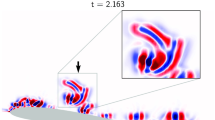Abstract
As the computational fluid mechanics community is advancing rapidly, the need to assimilate and compress the high-fidelity data is increasing simultaneously. Modal decomposition techniques like proper orthogonal decomposition and dynamic mode decomposition are widely used to capture important features (modes) of the flow field to facilitate reduced-order modeling. The frequency-domain equivalent of POD known as spectral proper orthogonal decomposition (SPOD) is currently emerging as a competitive alternative to these techniques. The present work analyzes the efficacy of SPOD compared to POD and DMD in obtaining effective latent space representations that enable accurate low-rank flow field reconstructions of unsteady flows. Suitability and shortcomings of the methods are highlighted for a canonical case of unsteady flow across a stationary cylinder at a Reynolds number of 100, based on the error metrics for low-rank reconstructions. It was observed that first two SPOD modes alone have constituted more than 90% of the energy in the flow. With just four SPOD modes, the flow field was reconstructed with less than 1% error, while it took six modes of POD and DMD to achieve the same accuracy.
Access this chapter
Tax calculation will be finalised at checkout
Purchases are for personal use only
Similar content being viewed by others
Abbreviations
- Re:
-
Reynolds number
- fs:
-
Vortex shedding frequency (Hz)
- \(X^{\dag }\):
-
Moore–Penrose pseudoinverse
- \(\underline{q}\):
-
Mean flow field
References
Taira K, Brunton SL, Dawson STM, Rowley CW, Colonius T, McKeon BJ, Schmidt OT, Gordeyev S, Theofilis V, Ukeiley LS (2017) Modal analysis of fluid flows: an overview. AIAA J 55(12):4013–4041
Rowley CW, Dawson STM (2017) Model reduction for flow analysis and control. Annu Rev Fluid Mech 49(1):387–417
Taira K, Hemati MS, Brunton SL, Sun Y, Duraisamy K, Bagheri S, Dawson STM, Yeh C-A (2020) Modal analysis of fluid flows: applications and outlook. AIAA J 58(3):998–1022
Lumley JL (1967) The structure of inhomogeneous turbulent flows. In: Atmospheric turbulence and radio wave propagation
Noack BR, Afanasiev K, Morzyński M, Tadmor G, Thiele F (2003) A hierarchy of low-dimensional models for the transient and post-transient cylinder wake. J Fluid Mech 497:335–363
Rowley CW, Mezić I, Bagheri S, Schlatter P, Henningson DS (2009) Spectral analysis of nonlinear flows. J Fluid Mech 641:115–127
Tu J, Rowley C, Luchtenburg D, Brunton S, Kutz J (2013) On dynamic mode decomposition: theory and applications. J Comput Dyn 1:11
Kou J, Zhang W (2017) An improved criterion to select dominant modes from dynamic mode decomposition. Eur J Mech B Fluids 62:109–129
Krake T, Reinhardt S, Hlawatsch M, Eberhardt B, Weiskopf D (2021) Visualization and selection of dynamic mode decomposition components for unsteady flow. Visual Inf 5(3):15–27
Towne A, Schmidt OT, Colonius T (2018) Spectral proper orthogonal decomposition and its relationship to dynamic mode decomposition and resolvent analysis. J Fluid Mech 847:821–867
Hellström LHO, Smits AJ (2017) Structure identification in pipe flow using proper orthogonal decomposition. Philos Trans Roy Soc A Math Phys Eng Sci 375(2089):20160086
Schmidt OT, Towne A, Rigas G, Colonius T, Brès GA (2018) Spectral analysis of jet turbulence. J Fluid Mech 855:953–982
Pickering E, Rigas G, Nogueira PAS, Cavalieri AVG, Schmidt OT, Colonius T (2020) Lift-up, Kelvin-Helmholtz and Orr mechanisms in turbulent jets. J Fluid Mech 896
Muralidhar SD, Podvin B, Mathelin L, Fraigneau Y (2019) Spatio-temporal proper orthogonal decomposition of turbulent channel flow. J Fluid Mech 864:614–639
Ghate AS, Towne A, Lele SK (2020) Broadband reconstruction of inhomogeneous turbulence using spectral proper orthogonal decomposition and Gabor modes. J Fluid Mech 888
Nidhan S, Chongsiripinyo K, Schmidt OT, Sarkar S (2020) Spectral proper orthogonal decomposition analysis of the turbulent wake of a disk at Re = 50,000. Phys Rev Fluids 5(12):124606
Weiss J (2019) A tutorial on the proper orthogonal decomposition. In: AIAA aviation 2019 forum, p 3333
Sirovich L (1987) Turbulence and the dynamics of coherent structures. I. Coherent structures. Quart Appl Math 45(3):561–571
Krake T, Weiskopf D, Eberhardt B (2019) Dynamic mode decomposition: theory and data reconstruction. arXiv preprint arXiv:1909.10466
Schmidt OT, Colonius T (2020) Guide to spectral proper orthogonal decomposition. AIAA J 58(3):1023–1033
Nekkanti A, Schmidt OT (2021) Frequency-time analysis, low-rank reconstruction and denoising of turbulent flows using SPOD. J Fluid Mech 926
Majumdar D, Bose C, Sarkar S (2020) Capturing the dynamical transitions in the flow-field of a flapping foil using immersed boundary method. J Fluids Struct 95:102999
Xu S, Wang ZJ (2006) An immersed interface method for simulating the interaction of a fluid with moving boundaries. J Comput Phys 216(2):454–493
Zhang H-Q, Fey U, Noack BR, König M, Eckelmann H (1995) On the transition of the cylinder wake. Phys Fluids 7(4):779–794
Lai M-C, Peskin CS (2000) An immersed boundary method with formal second-order accuracy and reduced numerical viscosity. J Comput Phys 160(2):705–719
Acknowledgements
We sincerely thank P.G Senapathy HPCE, IIT Madras, for providing the necessary computational resources to conduct this study.
Author information
Authors and Affiliations
Corresponding author
Editor information
Editors and Affiliations
Rights and permissions
Copyright information
© 2024 The Author(s), under exclusive license to Springer Nature Singapore Pte Ltd.
About this paper
Cite this paper
Thirunavukkarasu, A., Sundar, R., Sarkar, S. (2024). Modal Analysis of a Flow Past a Cylinder. In: Singh, K.M., Dutta, S., Subudhi, S., Singh, N.K. (eds) Fluid Mechanics and Fluid Power, Volume 3. FMFP 2022. Lecture Notes in Mechanical Engineering. Springer, Singapore. https://doi.org/10.1007/978-981-99-6343-0_55
Download citation
DOI: https://doi.org/10.1007/978-981-99-6343-0_55
Published:
Publisher Name: Springer, Singapore
Print ISBN: 978-981-99-6342-3
Online ISBN: 978-981-99-6343-0
eBook Packages: EngineeringEngineering (R0)




